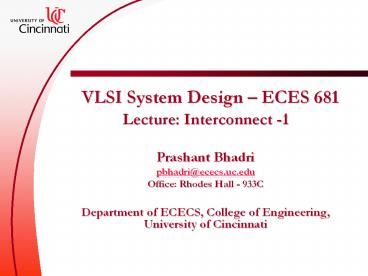VLSI System Design - PowerPoint PPT Presentation
Title:
VLSI System Design
Description:
VLSI System Design ECES 681 Lecture: Interconnect -1 Prashant Bhadri pbhadri_at_ececs.uc.edu Office: Rhodes Hall - 933C Department of ECECS, College of Engineering ... – PowerPoint PPT presentation
Number of Views:185
Avg rating:3.0/5.0
Title: VLSI System Design
1
VLSI System Design ECES 681
- Lecture Interconnect -1
- Prashant Bhadri
- pbhadri_at_ececs.uc.edu
- Office Rhodes Hall - 933C
- Department of ECECS, College of Engineering,
University of Cincinnati
2
Noise
- What is noise?
- auditory experience of sound that lacks musical
quality sound of any kind (especially
unintelligible or dissonant sound) - Electrical noise may be said to be the
introduction of any unwanted energy, which tend
to interfere with the proper reception and
reproduction of transmitted signals.
3
- External Sources
- Atmospheric
- Industrial
- Extraterrestrial
- Solar noise
- Cosmic noise
- Internal Noise
- This is the noise generated by any of the active
or passive devices found in the receiver. - Can it be a transmitter?
- How about on chip, in a system design, board
design etc.
4
Chip Noise
- Circuit noise includes all the disturbances
induced by the circuits topology. - Interconnect noise includes noise coming from
capacitive or inductive coupling between
interconnects. - Power supply noise, which refers to deviations of
the supply and ground voltages from their
nominal values. - Substrate noise in mixed-signal integrated
circuits the charge injected in the substrate by
the logic gates during the transitions may
interfere severely with the operation of
sensitive analog circuits.
Reference Bartolos Thesis, Chapter 1
5
Reference Digital System Engineering
http//eeclass.stanford.edu/ee273/
6
Reference Digital System Engineering
http//eeclass.stanford.edu/ee273/
7
Reference Digital System Engineering
http//eeclass.stanford.edu/ee273/
8
Reference Digital System Engineering
http//eeclass.stanford.edu/ee273/
9
Reference Digital System Engineering
http//eeclass.stanford.edu/ee273/
10
Reference Digital System Engineering
http//eeclass.stanford.edu/ee273/
11
Reference Digital System Engineering
http//eeclass.stanford.edu/ee273/
12
Reference Digital System Engineering
http//eeclass.stanford.edu/ee273/
13
Reference Digital System Engineering
http//eeclass.stanford.edu/ee273/
14
Reference Digital System Engineering
http//eeclass.stanford.edu/ee273/
15
Reference Digital System Engineering
http//eeclass.stanford.edu/ee273/
16
Shot Noise
- In a transistor the major contributor to noise is
called shot noise. - The formula for shot noise in a diode is given
as
17
Thermal Noise
- The noise generated by the agitation and
interaction of electrons is called thermal noise.
The internal kinetic energy of a particle can be
expressed through its temperature. - The kinetic energy of a body is zero at a
temperature of absolute zero. - The noise generated by a resistor, for example,
is proportional to its absolute temperature as
well as the bandwidth over which the noise is to
be measured.
18
- Any ordinary resistor not connected to a voltage
source will have a voltage associated with it. - If the load is noiseless and is receiving the
maximum noise power generated by our noisy
resistor then
19
Flicker Noise
- Flicker noise dominates the noise spectrum at
low frequency.
Reference Noise Sources in Bulk CMOS, paper by
Kent H. Lundberg
20
Reference Digital System Engineering
http//eeclass.stanford.edu/ee273/
21
Other Issues
- Charge Injection
- Capacitive Feed-through
22
Charge Injection
Solution
Problem
- When the switch is on, the voltage across the
sampling capacitor tracks the time-varying input
signal within the bandwidth. - Some charges are present in the MOS channel, this
is a result of forming a conducting channel under
the MOS gate. - When the switch is turned off, charges either
flow to the input source or to the sampling
capacitor and create a small voltage which . is a
function of several parameters which include
input impedance, source impedance, clock falling
edge, etc.
Reference http//kabuki.eecs.berkeley.edu/gchien
/thesis/Masters/appB/appendixB.pdf
23
Clock Feed-through
- When the clock voltage on the gate switches
between high and low, this voltage. - drop is coupled into the signal via the
capacitor divider. - The clock feed-through can be corrected to the
first order by using a differential signal path. - As long as the error is present on both signal
inputs and the same magnitude, it can be
cancelled by taking the input differentially. - This technique, once again, depends on the
absolute matching of transistors.
Reference http//kabuki.eecs.berkeley.edu/gchien
/thesis/Masters/appB/appendixB.pdf
24
Reference Digital System Engineering
http//eeclass.stanford.edu/ee273/
25
Reference Digital System Engineering
http//eeclass.stanford.edu/ee273/
26
How will you remove noise during the chip design
phase? ? ? ?Any Ideas ??
27
Noise Figure
- Used to assess the performance.
- Additionally compares two devices in order to
evaluate their performance compares the signal
and the noise at the same point to ensure that
noise is not excess. - This term is used to describe how noisy a device
is. - It is a ratio of the signal to ratio at the input
to the signal to noise ratio at the output.
28
Reading Assignment
- Paper Name Design Methodologies for Noise in
Digital Integrated Circuits - Author Kenneth L. Shepard
- Department of Electrical Engineering
- Columbia University, New York, NY 10027
- Website http//www.cisl.columbia.edu/faculty/shep
ard/group/dac_noise.pdf































